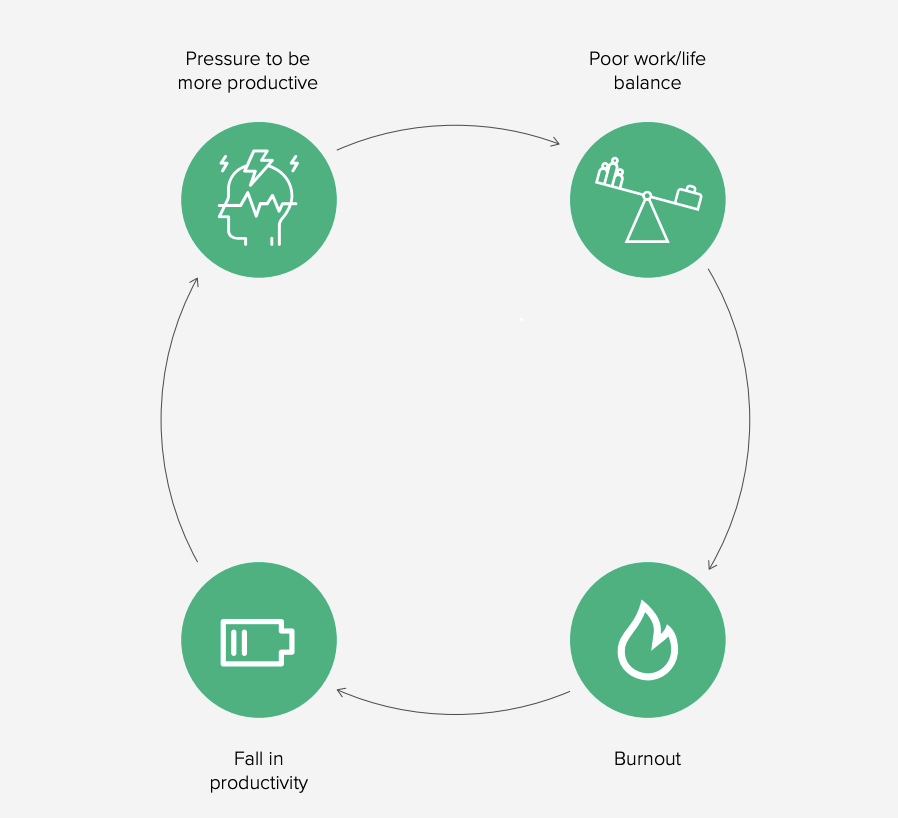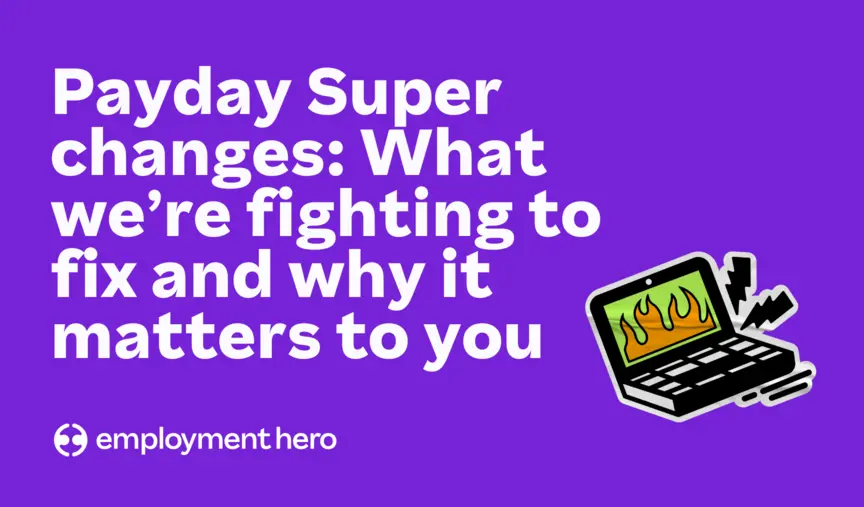5 Essential Employee Wellness Program Ideas
These cost-effective tips will help you build a holistic employee wellness program to be proud of.

After years of employers viewing their workforce as mere statistics, employee wellness has finally earned a place on the stage in the world of work.
If there’s one thing we know to be true, it’s that a low sense of wellbeing is a killer of great work.
When we feel off – whether it’s mentally, physically or even financially – our ability to work is greatly reduced. Poor wellbeing is the enemy of productivity, creativity and fulfilment. It’s hard to be a great employee when you don’t feel your best.
Sometimes, our physical health will follow life’s natural highs and lows. No one is going to be feeling amazing and working at 100%, every minute of every day.
Employers can, however, do plenty of things to boost their team’s health and happiness, so they are more likely to feel their best at work. For inspiration on designing a world-class wellness program, check out top companies with workplace wellness programs.
Employee wellness programs can do wonders for your employees wellbeing, and these wellness programs can do wonders for organisational growth.
What is an employee wellness program?
An employee wellness program is your business’ set of unique offerings that support employee wellness. It refers to the different kinds of benefits you provide your employees as part of their contract.
A good corporate wellness program will have a holistic approach: in other words, it will incorporate mental health, financial and health benefits.
If you are yet to implement an employee wellness program at your company due to concerns about cost and confusion over what it actually entails, fear not. We’ve got you covered with some cost-effective tips that you can start actioning today.
But before we get started, we must make an important public service announcement: by ‘employee wellbeing,’ we do not mean those free fruit bowls or cheeky snacks you have in the office kitchen. It entails so much more.
Key points:
- Employee wellness programs, going beyond just physical health, can significantly improve work-life balance, reduce stress, and boost organisational growth.
- Poor employee wellbeing affects productivity, creativity, and fulfilment.
- While not mandatory, businesses benefit from having wellness programs to improve employee experience.
- There needs to be more than just snacks; a comprehensive wellness strategy is necessary.
- While wellness programs can boost employee morale and wellbeing, they can’t address core organisational issues like overworking.
- Leadership’s support is the key to successfully integrating a wellness program into an organisation’s culture.
For the latest and greatest trends in employee wellness in the workplace, read about workplace wellness trends to watch out for.
How can we define employee wellbeing?
Employee wellness is the level of wellbeing within your team. This sense of health isn’t just constrained to the office; it refers to an overall sense of mental wellness that a person experiences.
Employee wellbeing can be threatened by factors that happen internally or externally to the workplace. For example; rising inflation is an external factor that can reduce financial wellness and employee wellbeing; a culture of working long hours is an internal factor that can impact employee wellbeing and mental health.
This is to say that employee wellbeing is a complex and multifaceted concept, that’s not always within an employer’s control. But there are many things that employers can do that have a positive impact.
Zen vibes, unlocked.
Is an employee wellness program required for businesses?
The short answer is no.
Businesses are not legally required to have an employee wellness program, and it’s extremely unlikely that you’ll get a slap on the wrist for not having one (of course, always double-check the employment laws in your country).
It generally does not fall into the non-negotiable category alongside things like employment contracts, payroll or policies.
The long answer?
If you care about the costs of turnover, having a productive team and building an innovative workplace culture – you should care about employee wellness. It’s one of the best tools that employers have when it comes to shaping employee experience.
To gain meaningful feedback, consider using a template for employee wellbeing survey questions to help you form a dynamic workplace wellness program.
Why are employee wellness programs important?
Chances are, you might be thinking that this sort of thing doesn’t concern you as the employer. After all, things such as personal financial health and physical health should remain at the employees’ discretion, right?
Our recent wellness at work report can help shine a light on why this mindset is no longer applicable in today’s world of work. It found that many employees worldwide are struggling with work burnout, it is proving hard to remain productive thanks to a sense of extreme fatigue.

Benefits of an employee wellness program
Great leaders know that healthy and happy employees create more effective teams that stick with your business. The data doesn’t lie, our report found that employees who rated their employer’s commitment to wellness positively were 48% more likely to say they were loyal.
Putting together an employee wellness program that considers your team’s unique set of needs sends a clear message; you care about your employees, and you’re willing to invest in them.
And if you don’t create an employee wellness program? Well, then you’re sending different kinds of messages; I don’t have time to consider your needs, your wellbeing is not my priority or – worst of all – I don’t care about your health. And we know this is not the case!
Not sold on the idea? Here are some benefits of having an employee wellness program.
1. Reduce work-related stress
Have you ever worked in an organisation where everyone seemed a little… intense? Work-related stress is a serious problem for organisations, and it’s often contagious. It can easily become part of a company’s culture.
A report from PWC indicates that workplace stress costs Australian businesses around $11M annually. In the US, it’s estimated that around one million people every day are absent from work due to job stress. It’s a big issue that employers need to examine.
Work-related stress is a key area where an employee wellness program and day-to-day company operations overlap. While there are plenty of things that a program can do to support physical wellness and mental health, it’s also important that employers create a low-stress business environment.
This can come from communicating well, distributing reasonable workloads and promoting work-life balance.
2. Better work-life balance
Poor work-life balance is such a big threat to your employee experience we figured it was worth its own point.
Our wellness at work report also found that workers with poor work-life balance were 67% more likely to feel burnout from their work. Poor work-life balance also had very little payoff for the employee, or the business, as those who were impacted were 174% more likely to experience low levels of productivity.
Employees are unlikely to achieve this sense of balance simply through employee wellness programs – it really needs to be an organisational change.
As a leader, ask yourself why your employees’ work may be spilling into their personal lives. Are their workloads too heavy? Are they always on call or contactable? Are they mimicking behaviour from upper management?
3. Improved occupational health
Occupational health, or ‘occupational satisfaction’, can be a forgotten part of workplace wellness, but we guarantee your employees wellbeing will be better if you make it a priority for your team.
Ocupational health can be defined as how fulfilled employees are with the work that they are engaging with. It measures how strongly employees associate with the values, beliefs and goals relating to the work that they do.
When your team has a strong sense of occupational health, they feel inspired and driven to do their best work. Collectively, the employee experience is motivated by a sense of team spirit and alignment towards the company’s mission; individually, team members feel like their career is positively evolving and developing through their work.
4. Healthier employees
Physical health has traditionally been a primary focus for employee wellness programs, as its impact on employee health is clearly visible.
When you provide nutritious food, promote ergonomic health, and offer fitness programs or opportunities for physical activity, you make it easier to encourage employees to feel better.
The impacts of a healthy lifestyle are well known; employees feel more energised, they may find it easier to focus, and they can prevent muscle soreness and tension, amongst many other wellness benefits.
Having support for good physical health makes for a happier team that can work to their full potential.
5. Creates a sense of belonging
Belonging is a factor that straddles diversity and inclusion, employee wellness and employee engagement. Another one of our wellness trends to watch in 2022, fostering a sense of belonging, can make all the difference to the wellbeing of your team members.
When a person feels a sense of belonging in their workplace, they feel comfortable being their authentic selves. When a business has a company culture that embraces all of its workers, employees are more likely to engage in wellness programs.
Everyone benefits from this increase in diverse thought, problem-solving becomes easier, and the team can achieve a better sense of overall wellness.
If you are looking to support your employees’ mental wellbeing in the workplace, download our free workplace wellness bundle and get started today.
Employee wellness program ideas
A successful wellness program should include a wide range of benefits. These can range from wellness initiatives to mental health programs, access to healthy food/snacks, flexible work schedules and more.
Remember – it should promote a healthy work-life balance, not be a reason for your team to stay longer hours.
Your employee wellness program should be tailored to your team and ideally influenced by something like an employee wellness survey.
However, there are some key common areas that you should keep in mind when you put your program together.
Informed by our findings, we suggest that the most effective common elements of an employee wellness program would look a little something like this…
1. Financial education and support
Our report found that a huge 63% of employees are experiencing financial stress, which is leading many to feel demotivated at work or seek alternative or additional employment.
With inflation skyrocketing globally and many countries lacking formal personal finance education, it’s no surprise that many people feel that the financial rug has been pulled from under them.
Employers can, and should, help their teams fill financial literacy gaps. Our research found that employees are looking for employer guidance, especially when it comes to retirement and pensions, and savings.
Remember, financial wellness initiatives might fall on deaf ears if your team doesn’t feel like they are being paid fairly – so always run a little temperature check before you start offering it.
If you’ve had lots of complaints about pay or you’re not sure if your team’s salaries are in-line with industry standards, resolve this first.
How can your business support employee financial literacy?
- Educate employees by offering free sessions with a qualified financial advisor to your team
- Run training sessions with general information from a qualified financial advisor
- Share official, ideally government, financial information and resources with your team
- Provide discounts on everyday items and services through a benefits platform like Employment Hero
- Set up groups to share savings tips and goals
2. Provide tools to tackle burnout
Employee mental health was another hot topic throughout our report. Specifically, burnout.
Burnout is affecting well over half of employees, with 56% of our survey respondents expressing that they had felt burnout within the last three months. After two relentless years of uncertainty, pivoting, disappointments, and fear (need we go on?), employees are feeling overwhelmingly exhausted.
Everyone, everywhere. Burnout pushes employees to the edge. It can cause absenteeism and a drop in motivation, as well as being the slippery slope to more mental health problems like depression and anxiety. Smart employers and leaders will know that there’s no time to waste, burnout must be addressed here and now.
What mental health benefits can you provide to employees?
- Open up the discussion around mental health in 1:1s, and train your managers on how to have these conversations
- Get involved in events like World Mental Health Day, and use them as an opportunity to share resources about mental health
- Encourage working from home or hybrid working
- Organise team bonding events, be they virtual or in-real-life
- Encourage mental health days, allowing your team to take sick days when they need mental or physical relief
3. Learning and development pathways
Employee development has not traditionally been a part of an employee wellness program, but it should be, especially when looking at the changing sentiments around careers.
To resist the impacts of the Great Resignation, occupational wellness needs to be on the agenda. One way to incorporate this into your employee wellness program is by constructing learning and development opportunities that truly invest in your team members.
How can your business support professional development?
- Financially support your employees to complete training at external institutions and providers that will fill gaps in their knowledge
- Match up senior and junior members of your team for mentorship
- Use goal-setting frameworks like Objectives and Key Results (OKRs), so that your team know they are working towards a big picture and making an impact
- Always consider internal talent for promotion when reviewing new roles
4. Health benefits
Before we get into the list of health benefits, keep in mind; that health can and should include both mental health, as well as physical fitness.
While healthy lifestyles reduce health risks and improve overall health, physical wellness support should not be limited to just fitness classes (online or in-person).
You might also consider setting a budget for an ergonomic home office set up for your employees. This budget can be limited to, for example, $250 per person, and you can choose to stipulate whether or not this will be topped up or is a one-off use.
What health benefits can your business provide?
- Access to online fitness classes
- Providing healthy snacks for employees in the office
- Providing health insurance
- Discounts on gym memberships and health assessments;
- Offering smoking cessation programs
5. Ergonomics
It’s one of the least cool parts of physical health, but ergonomics is increasingly in the spotlight of employee wellness.
It was an existing issue before the pandemic, but working from home has increased the risks of bad ergonomics. We’re feeling the effects of dodgy chairs, distracting environments, sitting for hours on end and ‘working from couch’.
While we believe the working from home revolution was one of the few silver linings to come out of the last two years, not using the right equipment to do, it can cause aches and pains.
It’s easy to brush off ergonomics as a non-essential, but if you get it right in your workplace, you promote your team’s physical and muscular health.
If you get it wrong, you could be causing your employees consistent aches and pains. Get it really wrong, you could be facing increased workplace compensation claims.
How can your business support employee ergonomics?
- Invest in better chairs in your office, and supply these or provide a chair budget for remote employees
- Provide headsets and monitors to assist with posture and reduce neck strain
- Encourage and provide time for movement or walking breaks throughout the workday
- Organise walking catch-ups, be they in-person or over the phone

What employee wellness programs won’t do for your employees
Although a workplace wellness program can definitely help your employees and lead to organisational growth, the reality is that putting a fruit bowl in the kitchen and offering a weekly yoga class won’t solve every worry your employees are currently facing.
When properly designed and introduced, a workplace wellness program has the power to improve the happiness and overall wellbeing of your team.
But, workplace wellness programs need to be designed effectively. They need to be thoughtful. They need to be considered. And they need to be measured.
You don’t want to splash the cash on a wellness program that misses the mark.
It takes time and consideration to get a workplace wellness program right so you can reap all of the benefits. And if you get it wrong, it can be an endless money pit that can be an anti-goal of what you hoped for, and no one wants that.
You need to conduct employee surveys and learn what your employees want. You need to find out where they need the most support.
You may think this is a bit of an odd topic to cover, but hear us out. We want you to understand that a wellness program won’t solve organisational issues, and there are a few things to watch out for when you introduce one into your business.
Ready to learn what a wellness program won’t do for your team?
They don’t correct a culture of overworking
A culture of overworking can be detrimental to employee wellbeing. Stressed, overworked and burnt-out employees not only reduce productivity but can increase rates of absenteeism.
A recent study by Harvard Business Review showed that a culture of overworking is backfiring on both employers and employees in the worst possible way.
No employer (or employee) wants this…
To sum it up, long days, long nights and working on weekends are doing more damage than good – with only 1 – 3% of the population being able to manage increased hours before they begin to experience an influx of mistakes.
Not only this, the study revealed that managers couldn’t even tell the difference between employees who actually worked 80 hours a week, and those who just pretended to – a telltale sign that overworking, does not work.
So while you may think that having all the bells and whistles of employee wellness programs is doing your employees a world of good, you may need to go back to basics and assess how your team is really feeling.
Not sure how to get a gauge on how your employees are feeling? Employment Hero’s Custom Surveys and Happiness Score can help you gain meaningful feedback.
Take a look at the Custom Surveys demo below. 👇
https://www.youtube.com/watch?v=4rhG5L7bp84
They don’t replace the need for additional headcount
Let’s face it. A workplace wellness program isn’t going to help your team alleviate stress if there’s an obvious need for additional headcount.
While employee wellness initiatives may initially help with managing stress, it’s not sustainable for one employee to be carrying the workload of three.
It needs to be ingrained in a workplace’s culture
When the time comes to launch your workplace wellness program, you need leadership and senior management to lead by example. You need to have it ingrained in your culture and have everyone live and breathe it.
The last thing you want is to offer a wellness program but then have the actions or expectations of your leadership team contradict it. Chances are, your team and future candidates will see right through it.
Are you ready to prioritise employee wellbeing?
Creating employee wellness programs can not only improve employee health, but it will also do wonders for your team’s overall wellbeing, productivity and engagement. Think about all the benefits that improved employee morale, better workplace culture and increased employee engagement could have for your business.
A great employee wellness program can make these benefits a reality.
However, wellness programs are not a one size fits all approach and should be thoughtfully designed, considered and measured. You need to consider your employees needs and address areas of organisational concern before you start splashing the cash on wellness initiatives.

Related Resources
-
 Read more: NSW Government introduces Portable Long Service Scheme for the Community Services Industry
Read more: NSW Government introduces Portable Long Service Scheme for the Community Services IndustryNSW Government introduces Portable Long Service Scheme for the Community Services Industry
The NSW Government has introduced portable long service leave for the community services industry. Learn what it is and what…
-
 Read more: Payday Super changes: What we’re fighting to fix and why it matters to you
Read more: Payday Super changes: What we’re fighting to fix and why it matters to youPayday Super changes: What we’re fighting to fix and why it matters to you
Big changes are coming to how superannuation is paid in Australia. Here’s what we’re asking Treasury to seriously consider updating…
-
 Read more: Why choice in superannuation matters
Read more: Why choice in superannuation mattersWhy choice in superannuation matters
What could be coming when Payday Super hits and what Employment Hero is doing about it.












